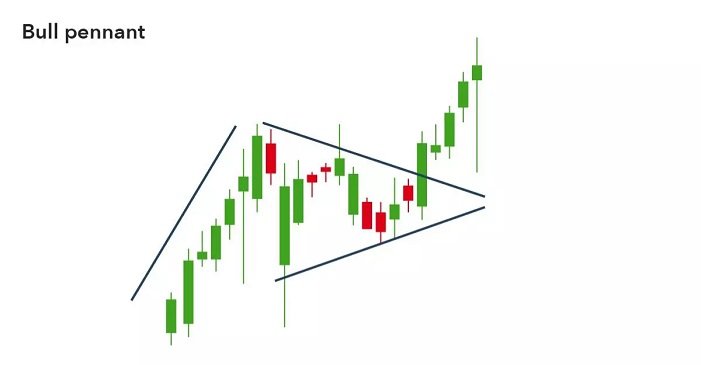In the world of technical analysis, recognizing chart patterns is crucial for predicting potential price movements. One such pattern that often signals a continuation of a bullish trend is the bull pennant. In this post, I’ll explain what a bull pennant is, how to identify it, and why it’s a valuable tool for traders.
What Is a Bull Pennant?
A bull pennant is a continuation pattern that appears during a strong uptrend. It indicates that the price is taking a brief pause before continuing its upward movement. The pattern resembles a small symmetrical triangle or “pennant” following a significant price surge, known as the “flagpole.”
Key Characteristics of a Bull Pennant
To correctly identify a bull pennant, look for the following features:
- Flagpole: The first part of the pattern is a sharp upward price movement, which forms the flagpole. This surge is usually accompanied by high trading volume, indicating strong buying interest.
- Consolidation Phase: After the flagpole, the price enters a brief consolidation phase, where it trades within a small, symmetrical triangle. During this period, the price forms lower highs and higher lows, creating the pennant shape.
- Breakout: The pattern is confirmed when the price breaks out above the upper trendline of the pennant with increased volume. This breakout suggests that the previous uptrend is likely to continue.
How to Trade a Bull Pennant
Trading a bull pennant can be rewarding, especially when the pattern is confirmed by a strong breakout. Here’s how you can trade it:
- Identify the Pattern: First, ensure that the pattern fits the characteristics of a bull pennant—sharp upward movement followed by a small, symmetrical triangle.
- Wait for the Breakout: Don’t enter the trade prematurely. Wait for the price to break above the upper trendline of the pennant, ideally with a spike in volume.
- Set Your Entry Point: Once the breakout is confirmed, you can enter a long position. The ideal entry point is just above the upper trendline of the pennant.
- Determine Your Target: The target price is usually calculated by adding the height of the flagpole to the breakout point. This gives you an idea of where the price might move next.
- Use Stop-Loss Orders: To manage risk, place a stop-loss order just below the lower trendline of the pennant. This will protect you in case the breakout fails.
Why the Bull Pennant Is Important
The bull pennant is a powerful continuation pattern because it reflects a brief pause in an uptrend, allowing traders to catch the next wave of the price movement. Understanding this pattern can help you identify potential breakout opportunities and make informed trading decisions.
Common Mistakes to Avoid
While trading bull pennants can be profitable, there are a few common mistakes to watch out for:
- Entering Too Early: Entering the trade before the breakout is confirmed can lead to premature losses if the price reverses within the pennant.
- Ignoring Volume: Volume is crucial in confirming the validity of the breakout. A breakout without significant volume may indicate a false move.
- Overlooking Market Conditions: Always consider the broader market context. If the overall market is bearish, a bull pennant might not be as reliable.
Conclusion
The bull pennant is a key pattern that can help traders spot continuation opportunities in a bullish trend. By learning how to identify and trade this pattern, you can improve your chances of capturing profitable moves in the market. Remember, patience and confirmation are essential when dealing with bull pennants, so always wait for the breakout before making your move.

